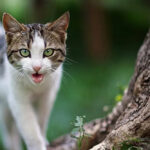As dedicated content creators at solcat.net, we understand the importance of preventative care in ensuring a long and healthy life for your cat. At the heart of feline preventative medicine is the FVRCP vaccine. Veterinarians highly recommend this core vaccine to safeguard cats of all lifestyles, indoor or outdoor, from serious and contagious diseases. This guide will explain how the FVRCP vaccine works to protect your beloved companion.
Understanding Core Vaccines for Cats
The FVRCP vaccine is categorized as a core vaccine for cats. Core vaccines are considered essential for all cats, irrespective of their living environment – whether they spend their days indoors or explore the great outdoors. Alongside the Rabies vaccine, which is legally mandated in many regions, FVRCP forms the cornerstone of feline vaccination protocols.
It’s a common misconception that indoor cats are shielded from infectious diseases. However, the viruses responsible for conditions preventable by the FVRCP vaccine are remarkably resilient and can survive on surfaces for up to a year. This means that even a brief, unsupervised venture outside or indirect contact through contaminated objects can expose your indoor cat to these dangerous pathogens, putting their health at serious risk.
Diseases Prevented by the FVRCP Vaccine
The FVRCP vaccine is a combination vaccine expertly formulated to protect your cat against three highly contagious and potentially fatal feline diseases. The acronym FVRCP itself breaks down the conditions it targets: Feline Viral Rhinotracheitis (FVR), Feline Calicivirus (C), and Feline Panleukopenia (P). Let’s delve deeper into each of these diseases.
Feline Viral Rhinotracheitis (FHV-1)
Feline Viral Rhinotracheitis, also known as FVR or feline herpesvirus type 1 (FHV-1), is a leading cause of upper respiratory infections in cats, accounting for a significant 80-90% of cases. This disease affects the upper respiratory system, including the nose and trachea, and can also cause complications during pregnancy in cats.
Symptoms of FVR can vary in severity but commonly include fever, sneezing, inflammation of the eyes and nasal passages, and discharge from the eyes and nose. While healthy adult cats may experience mild symptoms that resolve within 5 to 10 days, severe cases, particularly in vulnerable cats, can persist for six weeks or longer.
Kittens, senior cats, and cats with weakened immune systems are at higher risk of developing severe and prolonged FHV-1 infections. In these susceptible groups, symptoms can worsen, leading to depression, loss of appetite, significant weight loss, and painful oral ulcers. Furthermore, bacterial infections are a frequent secondary complication in cats already battling feline viral rhinotracheitis.
A crucial aspect of FHV-1 is its latency. Even after apparent recovery, the virus remains dormant within the cat’s body and can reactivate throughout their life, causing recurrent episodes of illness, especially during times of stress or immune suppression.
Feline Calicivirus (FCV)
Feline Calicivirus (FCV) is another major viral culprit behind upper respiratory infections and oral disease in cats. This highly contagious virus presents a significant health challenge in feline populations.
The symptoms of FCV infection are diverse and can include nasal congestion, sneezing, conjunctivitis (eye inflammation), and discharge from the nose and eyes, which can be clear or yellowish. A hallmark symptom of FCV is the development of painful ulcers in the mouth, commonly found on the tongue, palate, lips, or nose. Infected cats often exhibit a constellation of systemic signs such as loss of appetite, weight loss, fever, enlarged lymph nodes, squinting, and lethargy.
It’s important to recognize the existence of numerous strains of FCV, each with varying degrees of virulence and clinical manifestations. Some strains can induce pneumonia, characterized by fluid accumulation in the lungs, while others can trigger systemic illness with symptoms like fever, joint pain, and lameness. This variability underscores the importance of vaccination to provide broad protection against FCV.
Feline Panleukopenia (FPL)
Feline Panleukopenia (FPL), commonly known as feline distemper, is an extremely serious and widespread viral disease in cats. This highly contagious virus targets rapidly dividing cells in the bone marrow, lymph nodes, and intestinal lining, leading to severe systemic illness.
The clinical signs of FPL are often dramatic and include depression, anorexia (loss of appetite), high fever, lethargy, vomiting, severe diarrhea (often bloody), nasal discharge, and dehydration. The profound impact on the bone marrow and immune system leaves affected cats highly vulnerable to secondary infections.
While FPL can affect cats of any age, it is particularly devastating in kittens, often proving fatal. The severity of the disease and the lack of specific antiviral medications make supportive care crucial. Treatment for feline panleukopenia focuses on managing symptoms such as dehydration and shock through intravenous fluid therapy and intensive nursing care. Prevention through vaccination is paramount in protecting cats from this deadly disease.
Optimal Timing for FVRCP Vaccination
To ensure your feline companion receives the best possible protection against FHV, FCV, and FPL, a carefully timed vaccination schedule is essential. For kittens, the initial FVRCP vaccination is recommended starting at 6-8 weeks of age. Due to the presence of maternal antibodies that can interfere with vaccine efficacy, a series of booster shots are necessary. These boosters are typically administered every three to four weeks until the kitten reaches 16-20 weeks of age.
Following the kitten series, another FVRCP booster is crucial when your cat is just over one year old. Thereafter, to maintain continuous protection, FVRCP booster vaccinations are recommended every 3 years throughout your cat’s adult life. This established protocol provides robust and long-lasting immunity against these serious feline diseases.
Understanding Potential Side Effects of the FVRCP Vaccine
Vaccine side effects in cats are generally uncommon and, when they do occur, are typically mild and transient. The vast majority of cats tolerate the FVRCP vaccine without any adverse reactions. However, it’s important to be aware of potential, although rare, side effects.
Mild side effects may include a slight fever and a temporary feeling of malaise or being “off-color” for a day or two following vaccination. It’s also not unusual to observe mild, localized swelling or tenderness at the injection site. These mild reactions are generally self-limiting and resolve without intervention.
In very rare instances, more pronounced reactions can occur. These more severe reactions typically manifest rapidly, often within minutes to a few hours after vaccination, and almost always within 48 hours. Signs of a more serious reaction may include hives (urticaria), swelling around the face, lips, or eyes (angioedema), intense itching, fever, diarrhea, vomiting, and difficulty breathing.
Should your cat exhibit any of the more severe symptoms listed above after receiving the FVRCP vaccine, it’s crucial to seek immediate veterinary attention. Contact your veterinarian without delay or take your cat to the nearest emergency animal hospital. Prompt intervention can effectively manage these rare but potentially serious reactions.
Disclaimer: This information is for educational purposes only and should not be considered as a substitute for professional veterinary advice. Always consult with your veterinarian for any health concerns or before making any decisions related to your pet’s health.
Is it time for your cat’s FVRCP vaccination? Contact us today!
Protect your feline friend from preventable diseases and ensure their long-term well-being with the FVRCP vaccine. [Contact our team]([invalid URL removed]) at Falls Road Animal Hospital to schedule an appointment for your cat or kitten. Our experienced veterinary professionals are dedicated to partnering with you in providing the best possible care and a healthy, happy life for your beloved cat.


